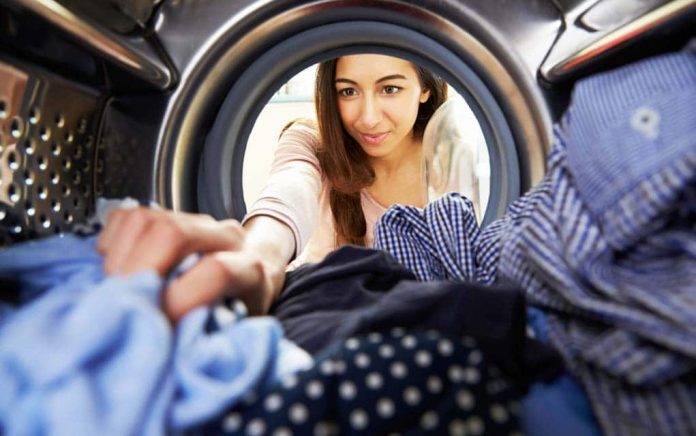
If you are among the minority of people who hang their clothes on a line to dry, not only are you saving a ton of money (dryers suck up lots of energy), you and your family are also avoiding the nasty chemicals that are harbored in dryer sheets.
Unfortunately, the fragrant dryer sheets we use to remove static from our clothes can contain carcinogens, neurotoxins, and respiratory irritants. You won’t see a list of these substances on the dryer sheet box because there are no laws requiring them to be listed (not unlike labeling laws for feminine hygiene products, which we unveiled a few years back). These chemicals are released from the sheets and spread over the clothes and linens in your dryer, and then come into contact with your skin where they can be absorbed into your body, including sensitive areas.
What types of chemicals are lurking in dryer sheets? To prevent clothes from sticking together, dryer sheets are impregnated with cationic chemicals that neutralize negative particles on clothes. These chemicals also cause fabric fibers to rise, making clothes feel softer than they do when they dry in the sun.
Read about 5 tips to make doing laundry greener
Another “benefit” of these chemicals is that they usually make it unnecessary to iron your outfits because they leave a light waxy coating on your clothing. We have also been told our laundry should smell “fresh and clean,” so dryer sheets have a fragrance. Fragrances, which are a trademark of dryer sheets, are a significant source of hormone disruptors.
Toxins in dryer sheets and fabric softener
Only a few studies have attempted to identify the pollutants in dryer sheets and fabric softener, which are typically grouped under the same classification because their ingredients tend to be similar. (A little history lesson: Dryer sheets were introduced after fabric softeners. Although the former were initially designed to stop static cling, they were eventually formulated to provide fabric softener as well, thus the kinship between the two products.)
Read about are there toxins lurking in your family’s clothes
One 2008 study from the University of Washington noted 15 substances in the dryer sheets tested, including two carcinogens (benzyl acetate and limonene) and several neurotoxins. Here are a dozen toxins you may find in dryer sheets and fabric softener:
- Alpha terpineol. Known to cause central nervous system damage, respiratory problems, issues with muscle coordination, and headache.
- Benzyl acetate. A known carcinogen, it may also cause confusion, dry skin, red eyes, and dizziness. Inhaling the vapors can cause burning in the throat and breathing problems.
- Benzyl alcohol. Can affect the nervous system, causing confusion, dizziness, nausea, vomiting, headache, and even death.
- Biodegradable cationic softeners. Can cause nervous system damage, including confusion.
- Camphor. A neurotoxin that can cause cognitive symptoms such as confusion, dizziness, twitching muscles, and convulsions.
- Chloroform. A known carcinogen and neurotoxin.
- Dichlorobenzene. A possible human carcinogen, it may also irritate the skin, throat, and eyes.
- Ethanol. Considered to be “hazardous waste” by the Environmental Protection Agency.
- Ethyl acetate. Considered to be “hazardous waste” by the Environmental Protection Agency and can cause headache, irritated throat and eyes, and stupor.
- Limonene. A known carcinogen (specifically when it is exposed to ozone as it creates formaldehyde), it also can irritate the skin and eyes.
- Linolool. Known to cause central nervous system damage, respiratory problems, and to limit motor activity.
- Pentane. Associated with central nervous system damage, motor activity limitations, dizziness, nausea and vomiting, respiratory problems and loss of consciousness if inhaled.
In a study of products that contain endocrine disruptors and asthma-associated substances, dryer sheets were named as one of the products with the highest concentrations of endocrine disruptors. In addition, dryer sheet use has been associated with asthmatic effects, allergic contact dermatitis, and skin sensitivities.
Read about the 12 worst endocrine disruptors in your body
Safe, natural alternatives to conventional dryer sheets
If you are yearning for a safe, natural alternative to conventional dryer sheets (and you don’t want to or can’t hang your clothes out to dry), here are four for you to consider.
- Baking soda. Although adding 3 tablespoons of baking soda to the wash cycle won’t eliminate static, it will soften your clothes as well as remove those annoying detergent residues.
- White vinegar. You gotta love white vinegar for all of its super benefits, and here’s yet another one: a mere 2 ounces added to your rinse cycle will reduce static, get rid of stiffness in dried clothes, and remove detergent residue. Worried about mildew? Yes, it can eliminate that too.
- D-I-Y chemical-free dryer cloths. Soak a washcloth in white vinegar, wring it out, add a drop or two of your favorite essential oil, and toss it into your dryer.
- Dryer balls. You can purchase wool or nontoxic hypoallergenic balls or make your own wool dryer balls. They minimize static and also help clothes dry faster.
SourcesAnne C. Steinemann AC. Fragranced consumer products and undisclosed ingredients. Environmental Assessment Review 2008 July 23 online
Bright S. Here’s why you should never use dryer sheets again and what to use instead. Natural Living Ideas 2016 Apr 29
Dodson RE et al. Endocrine disruptors and asthma-associated chemicals in consumer products. Environmental Health Perspectives 2012 Jul; 120(7): 935-43
Environmental Working Group. Dryer sheets.
Snider J. Addicted to dryer sheets? Branch Basics 2015 Jan 15










